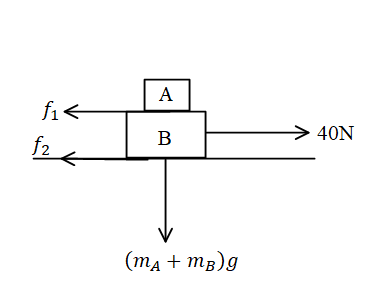Question
Question: A 5 kg block (A) is placed on a 10 kg block (B) which is at rest on the table. Coefficient of the fr...
A 5 kg block (A) is placed on a 10 kg block (B) which is at rest on the table. Coefficient of the friction between (A) and (B) 0.3 and between (B) and table is 0.4. A 40N horizontal force is applied on the block (B), then the friction force between the block (A) and (B) is:
A) 0.
B) 15N.
C) 60N.
D) 40N.
Solution
The limiting friction is defined as the maximum friction that can be generated between two surfaces. Friction force is the force which is generated due to rough surfaces and is always opposite to the direction of the motion of the body.
Formula used: The formula of the friction on anybody is given by,
⇒f=μ⋅R
Where friction is if the coefficient of friction is μ and the normal reaction is equal to R.
Complete step by step answer:
It is given in the problem that the a 5 kg block (A) is placed on 10 kg block (B) which is at rest on the table the coefficient of the friction between (A) and (B) 0.3 and between (B) and table is 0.4 when 40N horizontal force is applied on the block (B), then we need to find the friction force between the block (A) and (B).
The free body diagram is given by,

The limiting friction between (A) and (B) is equal to,
⇒f1=μ1R1
⇒f1=(0⋅3)(5×9⋅8)
⇒f1=14⋅7N………eq. (1)
The limiting friction between the block B and the ground is equal to,
⇒f2=μ2R2
⇒f2=(0⋅4)(15×9⋅8)
⇒f2=58⋅8N………eq. (2)
Since the force of 40N is applied on the block B therefore,
⇒40−f1=15⋅a………eq. (3)
Replace the value of the f1 from the equation (1) in equation (3)
⇒40−14⋅7=15⋅a
⇒15⋅i=25⋅3
⇒a=1525⋅3
⇒a=1⋅7ms−2.
The acceleration of the block B will bea=1⋅7ms−2.
The force on the block A isf1 which is equal tof1=14⋅7N. The force between the block (A) and (B) is approximately equal to 15N.
The correct answer for this problem is option B.
Note: It is advisable to students to understand and remember the formula of the friction as it can be helpful in solving these kinds of problems. There are two types of coefficient of friction for two conditions when the body is already moving the coefficient of kinetic friction acts on the body and for when the body is at rest initially the coefficient of static friction is acting on the body. The limiting friction acts on the body only when the body is at rest and about to just move.
